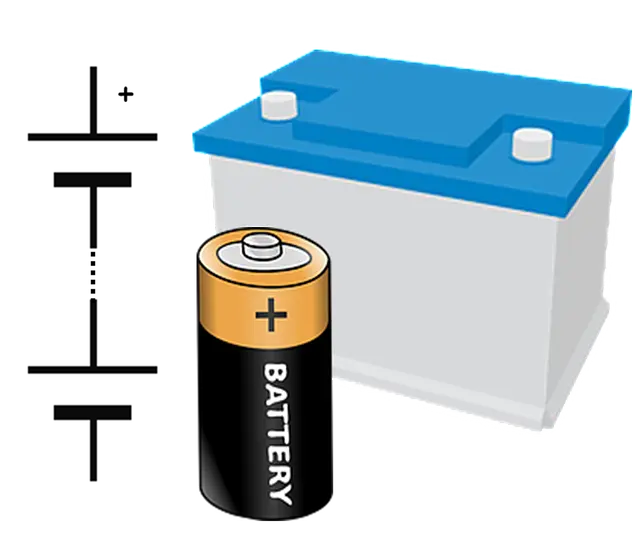Have you ever wondered about the distinction between a cell and a battery? People often use these terms interchangeably but denote different electrical energy storage components. Understanding their differences is crucial, especially when choosing the right power source for various applications. This article will delve into the depths of cells and batteries, exploring their composition, types, and how they differ.
Part 1. What is a cell?
When we talk about a cell in energy storage, we refer to the basic unit that converts chemical or electrical energy into electrical power. Cells are the fundamental building blocks of batteries, and they can function independently or be combined to form larger energy storage systems.
Cell Composition
A typical cell consists of several key components, including:
- The anode is the electrode through which current flows into the cell during discharge. Manufacturers typically make it from a reactive material that undergoes oxidation.
- The cathode is the electrode where reduction occurs during discharge. It usually comprises a material that readily undergoes reduction.
- The electrolyte is a medium for ion transport between the anode and cathode. It facilitates the chemical reactions necessary for energy generation.
- The separator serves as a physical barrier between the anode and cathode, preventing direct contact and short circuits while allowing the passage of ions.
Types of Cells
We can classify cells into various types based on their chemistry and applications. Some common types of cells include:
- Primary Cells: Primary cells, non-rechargeable cells, produce electrical energy until their chemical reactants deplete. You commonly find them in disposable batteries for devices like remote controls and flashlights.
- Secondary Cells: Users can replenish secondary cells by applying an external electric current. People commonly use them in devices such as smartphones and electric vehicles because they offer the advantage of reuse.
- Alkaline Cells: Alkaline cells utilize an alkaline electrolyte, typically potassium hydroxide (KOH), and are known for their long shelf life and stable voltage output. People widely use them in everyday devices.
- Lithium-Ion Cells: Lithium-ion cells have gained popularity due to their high energy density, lightweight nature, and ability to hold a charge for extended periods. People extensively use them in portable electronics, electric vehicles, and renewable energy systems.
Part 2. What is a battery?
While a cell represents the primary energy storage unit, a battery comprises multiple cells connected in series or parallel to provide a higher voltage or current output. A battery is an assembly of cells that generate and store electrical energy.
Battery Composition
A battery comprises multiple cells arranged in either series or parallel configurations, depending on the desired voltage and capacity. The components of a battery include:
- Cell: As mentioned earlier, a battery consists of one or more cells connected.
- Terminal: The terminals are the connection points between the battery and its power device. They allow the flow of current into and out of the battery.
- Casing: The casing provides structural support and protection to the cells and other internal components of the battery.
- Battery Management System: In some advanced batteries, manufacturers incorporate a management system to monitor and control factors like temperature, voltage levels, and charging/discharging processes.
Types of Batteries
Batteries come in various types, catering to diverse applications and requirements. Here are a few common types of batteries:
- Lithium-Ion Batteries: Lithium-ion (Li-ion) batteries, known for their high energy density and rechargeability, have revolutionized portable electronics and electric vehicles. They have become the go-to smartphone, laptop, and electric car options.
- Lead-Acid Batteries: Lead-acid batteries are among the oldest and most widely used battery technologies. You commonly find them in automotive applications, uninterruptible power supplies (UPS), and renewable energy systems.
- Nickel-Cadmium Batteries: Nickel-cadmium (NiCd) batteries offer good cycle life and high discharge rates. People commonly use them in portable power tools and emergency lighting systems.
- Nickel-Metal Hydride Batteries: Nickel-metal hydride (NiMH) batteries are popular for consumer electronics due to their higher energy density than NiCd batteries. People commonly use them in digital cameras, laptops, and cordless phones.
Part 3. Distinguishing between a cell and a battery
Now that we have explored the individual components and types of cells and batteries let’s highlight the key differences between them:
- Composition: Cells consist of two electrodes and an electrolyte, while batteries comprise multiple interconnected cells within a casing.
- Functionality: Cells can operate independently, whereas batteries require multiple cells to generate and store electrical energy.
- Voltage and capacity: Cells tend to have lower voltage and capacity compared to batteries, as batteries combine multiple cells to deliver higher voltage and current output.
- Applications: Cells are often used in small, low-power devices, while batteries find applications in various industries, including automotive, electronics, and renewable energy.
- Form factors: Cells are typically smaller and more compact. At the same time, batteries come in various sizes and shapes, from cylindrical cells to flat pouches.
- Energy density: Batteries generally have higher energy density than individual cells, enabling them to store more energy for longer durations.
- Rechargeability: While many cells can be rechargeable, batteries are almost always rechargeable, allowing for repeated use and recharging cycles.
- Complexity: Batteries are more complex than individual cells due to the interconnection of multiple cells, requiring additional circuitry and management systems.
Part 4. FAQs
-
How many cells are in a battery?
The number of cells in a battery can vary depending on its design and intended use. Some batteries contain a single cell, while others may have multiple cells connected in series or parallel to increase voltage or capacity. -
What is the primary difference between a cell and a battery?
A cell is the basic unit that generates electrical energy, while a battery is a collection of cells. The symbol for a cell typically consists of two parallel lines representing the electrodes, with a longer line indicating the positive terminal and a shorter line indicating the negative terminal. The symbol for a battery usually includes multiple cells connected, often depicted as parallel lines with alternating long and short lines to represent each cell’s positive and negative terminals. -
Is a lithium battery a cell?
No, a lithium battery is not a single cell but a type that uses lithium-based chemistry in its cells. Lithium batteries can consist of one or more lithium cells, depending on the specific battery configuration and application. -
Does 2 cells mean 2 batteries?
Not necessarily. Two cells could be part of a single battery if connected internally. However, if each cell is separate and independent, having two cells would mean having two separate batteries. The distinction depends on how the cells are arranged and connected within the overall battery design.
Related Tags:
More Articles

LiPo Battery Discharge Rate Guide & Calculation Tips
Understand LiPo battery discharge rates, C-ratings, and how to calculate max current. Essential guide for RC, drones, and electronics users.
High‑Capacity 3S LiPo Batteries: 5000 mAh vs. 10000 mAh
Compare 3S LiPo 5000mAh vs 10000mAh batteries by weight, power, and use. Find the best fit for your drone, RC car, or boat setup.
Top 5 Applications for Small 3S LiPo Batteries
Small 3S LiPo batteries power drones, RC gear, wearables, and robotics with high energy and low weight. Making them ideal for compact electronics projects.
Building and Charging Your Own 3S LiPo Pack: A Step‑by‑Step Guide
Learn how to build, balance, and charge a 3S LiPo battery pack safely at home with this complete DIY guide for hobbyists and beginners.
How to Choose the Right LiPo Battery Plug Type?
Discover the best LiPo battery plug types, how to choose them, and expert tips for safe usage, soldering, and maintenance.




